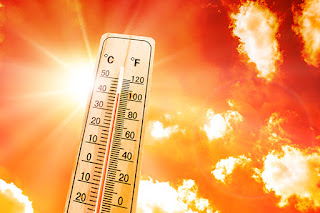Heat wave Preparedness: Protecting Human Health in a Warming World
Heatwaves have become increasingly frequent and intense due to climate change, posing significant risks to human health, particularly in the Mediterranean region. As the frequency and intensity of these extreme heat events continue to rise, prioritizing heatwave preparedness becomes crucial for safeguarding human health. Therefore, we must urgently explore various aspects of heatwave preparedness, emphasizing the importance of taking immediate action to protect vulnerable communities from the impacts of extreme heat in a warming world.
A heatwave refers to a prolonged period of abnormally high temperatures, surpassing the usual temperature variations in a particular region. Unlike normal temperature fluctuations, heatwaves can have detrimental effects on human health. They are primarily caused by a combination of factors, including atmospheric pressure patterns, humidity levels, and changes in wind patterns.
Early warning systems play a crucial role in predicting and mitigating the impacts of heatwaves. These systems utilize advanced meteorological data and temperature monitoring to forecast heatwave events accurately. Public alerts and notifications are then disseminated to ensure that individuals and communities are well-informed and can take the necessary precautions to protect themselves from the impending heatwave conditions. Today, our technology is advanced enough to supply specifically tailored information to each of us.
To effectively prepare for heatwaves, it is essential for individuals and communities to implement practical strategies. Staying hydrated is paramount during heatwaves, as adequate fluid intake helps regulate body temperature and prevent dehydration. Seeking cool shelter in air-conditioned or shaded areas is crucial to minimizing heat exposure. Additionally, wearing appropriate clothing, such as loose and lightweight garments, can facilitate better heat dissipation.
At the community level, creating heatwave preparedness plans is vital. These plans include public education campaigns, the establishment of cooling centers in vulnerable areas, and the development of community support networks to ensure that no one is left without assistance during heatwave events. Collaboration between local authorities, healthcare providers, and community organizations is essential to implementing effective heatwave preparedness strategies.
A key component of heatwave preparedness is the availability of adequate cooling infrastructure and resources. This includes the installation of air conditioning systems in homes, schools, and public buildings to provide relief during extreme heat events. Additionally, the establishment of cooling centers and shade structures in public spaces can offer temporary respite for individuals without access to air conditioning.
It is important to emphasize that equitable access to cooling resources is essential, particularly for disadvantaged communities. Socioeconomic disparities should not be a barrier to accessing life-saving cooling measures during heatwaves. By addressing these inequalities and ensuring an equal distribution of resources, we can protect the most vulnerable populations and reduce the health risks associated with extreme heat.
Public health agencies play a critical role in implementing heatwave response plans and interventions. These agencies work to raise awareness about the dangers of heatwaves through targeted campaigns that educate the public on heat-related illnesses, prevention strategies, and the importance of early intervention. Community outreach programs can provide valuable support by reaching out to at-risk individuals, distributing informational materials, and organizing local initiatives to address heatwave challenges.
In addition to awareness campaigns, health surveillance systems are vital to monitoring the health impacts of heatwaves. By collecting data on heat-related illnesses and tracking trends, public health agencies can identify high-risk areas and implement targeted interventions to protect vulnerable populations. This proactive approach helps save lives and minimize the strain on healthcare systems during heatwave events.
Long-term adaptation measures are essential for minimizing the impacts of heatwaves and building resilience in communities. Urban greening initiatives, such as creating parks, green spaces, and urban forests, can help mitigate the urban heat island effect and lower ambient temperatures. Planting trees strategically around buildings and streets can provide shade and reduce heat absorption, creating a more comfortable and cooler environment.
Cool roof initiatives, which involve applying reflective coatings or materials to rooftops, can significantly reduce the heat absorbed by buildings. This simple adaptation measure helps lower indoor temperatures, reduce the need for excessive air conditioning, and decrease energy consumption. Sustainable urban planning that incorporates heat-resilient design principles, such as proper ventilation, can also contribute to mitigating the impacts of heatwaves.
Highlighting successful case studies and best practices from cities and regions implementing heatwave adaptation strategies can inspire and guide others in their efforts. By sharing experiences and lessons learned, we can foster knowledge exchange and accelerate the adoption of effective adaptation measures worldwide.
Heatwave preparedness requires collaborative efforts and partnerships between various stakeholders. Government agencies, healthcare providers, community organizations, and individuals must come together to address the challenges posed by extreme heat. Governments play a crucial role in developing policies, allocating resources, and implementing heatwave preparedness plans.
Healthcare providers play a vital role in educating their patients about heatwave risks, providing guidance on preventive measures, and ensuring adequate medical support during heatwave events. Community organizations can contribute by organizing local initiatives, providing support to vulnerable individuals, and advocating for the needs of their communities.
Citizen participation and community engagement are crucial in fostering resilience to heatwaves. By involving the public in decision-making processes, encouraging community-led initiatives, and empowering individuals to take action, we can create a collective sense of responsibility and promote a culture of preparedness.
In conclusion, heatwave preparedness is paramount for protecting human health in a warming world. Understanding the nature of heatwaves, recognizing their associated health risks, and implementing early warning systems are critical steps in mitigating their adverse impacts. By investing in cooling infrastructure and resources, implementing public health interventions, adopting long-term adaptation measures, and fostering collaboration and partnerships, we can build resilience and safeguard our communities from the detrimental impacts of extreme heat. It is imperative that we address heatwave challenges promptly, adopt practical heatwave preparedness strategies at both individual and community levels, and take proactive measures to ensure the well-being of our communities. Together, we can adapt to the changing climate, prioritize heatwave preparedness, and create a more resilient and sustainable future for all.




Comments
Post a Comment